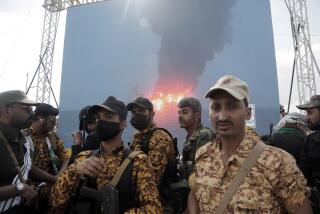Army Defends Baghdad Battle That Left 16 Dead
- Share via
BAGHDAD — U.S. commanders acknowledged Wednesday that their helicopters fired seven rockets and 30 high-caliber machine-gun rounds onto a crowded Baghdad street this week during a battle that killed 16 Iraqis and sparked a heated debate about how civilians often become the victims of U.S. firepower.
Army officials said the helicopter attack was an appropriate response to insurgents firing on U.S. soldiers from the vicinity of a Bradley fighting vehicle, which had been set ablaze by a suicide car bomb.
“The actions taken by our soldiers and pilots were clearly within their rights,” said Maj. Gen. Peter Chiarelli, commander of the Army’s 1st Cavalry Division, which patrols Baghdad.
U.S. officials said it was unclear what caused the casualties -- volleys from the helicopters, explosions from ammunition in the Bradley or insurgent fire. “We regret the loss of any innocent civilians,” said Col. Jim McConville, who heads the aviation brigade for the 1st Cavalry Division.
The carnage along the capital’s Haifa Street has enraged many Iraqis, who say that U.S. troops often attack without provocation and fire randomly when under assault.
The unusual public recounting of Sunday’s battle was an effort to defuse charges that the two helicopters fired randomly into a crowd of civilians.
Wednesday’s statements contradicted an earlier account, in which a U.S. military spokesman said the helicopters fired on the street to provide cover for escaping U.S. troops.
On Sunday, viewers around the world saw footage of the Haifa Street battle, which also injured 61 Iraqis. Among the dead was Mazen Tumeizi, a reporter for Al Arabiya, an Arab-language satellite channel, who was taping a report with the smoking U.S. armored vehicle in the background when an explosion occurred and he was hit.
“I’m dying!” Tumeizi gasped as he doubled over, screaming, in footage shown repeatedly on the Dubai-based channel. “I’m dying!”
Military officials here have adamantly denied Iraqi charges that U.S. forces bomb civilian targets in places such as Fallouja and fire indiscriminately when attacked in Baghdad and elsewhere. Arab-language news media repeat the charge that American soldiers are trigger-happy, damaging U.S. forces’ credibility with some Iraqis and across the Arab world.
U.S. commanders say their soldiers are fighting a guerrilla force that wears no uniform and quickly blends into the civilian population and are often required to respond swiftly to life-threatening situations. Urban settings give insurgents ample opportunities to fire from within crowds, apartment buildings and other civilian sites. Edgy U.S. troops on patrol have to view people on the streets as potential threats and approaching vehicles as possible car bombs.
Sunday’s deaths sparked a rancorous debate after the Army initially said the helicopters fired to scatter a crowd gathered around the burning armored vehicle. Iraqi commentators have suggested that it would have been more humane to allow the Bradley to be ransacked, or to have retaken it with ground forces.
“A tank can always be replaced, but you can’t replace human lives,” said Kadhim Sultani, chairman of the Iraqi National Human Rights Assn., a nongovernmental group.
But U.S. commanders said it was crucial to disperse the crowd and ensure no one looted the contents. Troops are authorized to use deadly force to protect “sensitive equipment” from falling into hostile hands, Maj. Gen. Chiarelli said.
Military commanders acknowledged Wednesday that earlier U.S. accounts that the helicopters were providing cover for escaping troops were incorrect. The Bradley’s six wounded soldiers had been evacuated and the troops had already retreated to a strong point more than 400 yards away by the time the two Kiowa Warrior helicopters appeared overhead about 7:30 a.m., commanders said.
Images of crowds celebrating around burning Humvees, tanks and other U.S. vehicles have become commonplace in post- invasion Iraq. Photographs now circulating on militant Islamic websites show a young man placing the black banner of Jamaat al Tawhid wal Jihad -- an insurgent group led by Jordanian-born militant Abu Musab Zarqawi -- into the armored vehicle’s cannon.
The Army said it was not the sight of the insurgent flag on the Bradley vehicle that triggered the helicopter strike. Commanders said a “preliminary investigation” showed that soldiers in the helicopters fired only after bullets from the vicinity of the disabled Bradley came their way.
The helicopters made three passes each and fired a total of seven rockets and 30 rounds from .50-caliber machine guns, Col. McConville said. He said soldiers in the helicopters were aiming at “insurgent or terrorist forces firing at our aircraft,” and not at civilians gawking and poking at the disabled vehicle.
Officials disavowed an earlier U.S. account that a rocket was fired at the Bradley to destroy it and ensure it did not fall into hostile hands. The fire was aimed solely at insurgents in the vicinity of the disabled vehicle, the commanders said.
The crowd dispersed after the firing, and U.S. ground forces were eventually able to reach the blazing vehicle and tow it away. U.S. officials could not say whether sensitive equipment had been looted.
At Karama Hospital in Baghdad on Wednesday, several survivors disputed the U.S. account.
“I saw no one among the people near or on top of the burning tank who had a weapon,” said Alaa Naeem Alwan, 30, who had shrapnel removed from his abdomen and was being treated for a broken leg. “The Americans felt angry when they saw the people celebrating and carrying the black banner” of Zarqawi’s group, he said.
Hamoodi Abdul-Hadi, 24, said gunmen who had earlier fired at U.S. ground troops had fled the area by the time the helicopters arrived.
“There were people surrounding the burnt tank,” Abdul-Hadi said, “but the fighters had left the scene by then.”
*
Times special correspondents Raheem Salman and Salar Jaff contributed to this report.
More to Read
Sign up for Essential California
The most important California stories and recommendations in your inbox every morning.
You may occasionally receive promotional content from the Los Angeles Times.









